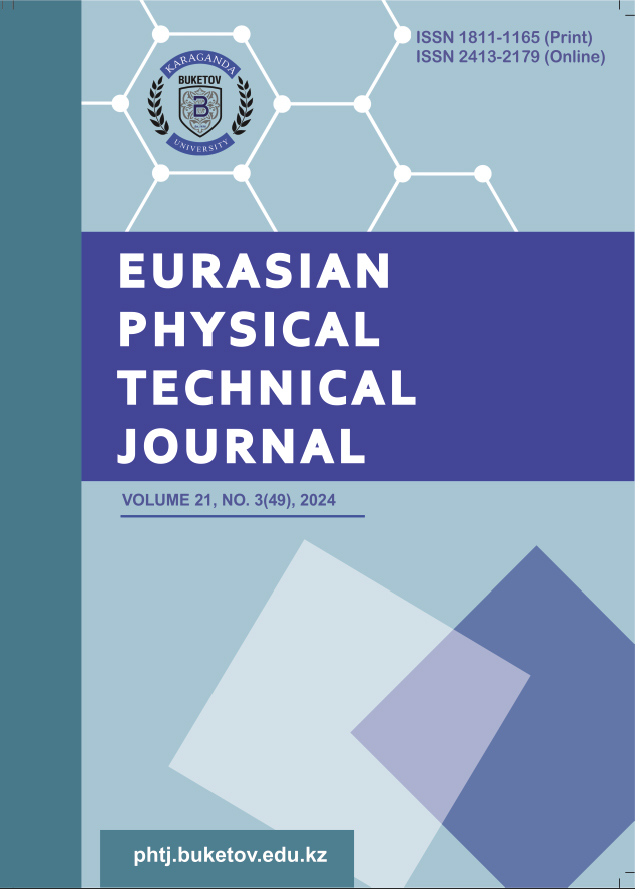Влияние влажности и кварцевого песка на коэффициент трения тормозной системы ветряной турбины.
DOI:
https://doi.org/10.31489/2024No3/117-124Ключевые слова:
ветряные турбины, состояние влажности, кварцевый песок, коэффициент тренияАннотация
Основные детали привода для горизонтальных ветряных турбин, включая коробку передач, генератор и тормозную систему, имеют очень высокие затраты на ремонт и замену и требуют много времени для завершения. В этой статье исследуется влияние загрязнения окружающей среды на поведение трибологии привода. Моделируется и исследуется экспериментальное исследование системы привода ветряной турбины. Механическая тормозная система ветряных турбин является предметом одного из тематических исследований, выбранных для этой исследовательской работы. В этом исследовании изучается, как примеси влияют на коэффициент трения тормоза ветряных турбин. Согласно результатам, коэффициент трения увеличивается с каждым увеличением скорости вала ветряной турбины. Также обнаружено, что размер частиц загрязняющих веществ значительно влияет на коэффициент трения. Кроме того, результаты могут дать полезную информацию о системе привода, которая при увеличении влажности с 30 мм3 до 90 мм3 значительно снижает коэффициент трения.
Библиографические ссылки
Alsyouf I., El-Thalji I. (2008) Maintenance practise in wind power systems: a review and analysis. Proceeding of the European Wind Energy Conference and Exhibition, Brussels, Belgium, 2588 – 2597. https://www.proceedings.com/content/005/005469webtoc.pdf.
Staino A., Basu B. (2013) Dynamics and control of vibrations in wind turbines with variable rotor speed. Enginnering Structures, 58 – 67. DOI: 10.1016/j.engstruct.2013.03.014.
Belhocine A., Ghazaly N.M. (2015) Effects of Material Properties on Generation of Brake Squeal Noise Using Finite Element Method. Latin American Journal of Solids and Structures, 12, 2 (8). DOI:10.1590/1679-78251520.
Babu B.C., Mohanty K.B. (2010) Doubly-fed induction generator for variable speed wind energy conversion systems–modeling and simulation. Int. J. Comput. Electr. Eng., 2(1), 141–147. DOI:10.7763/IJCEE.2010.V2.127.
Bhutta M.M.A., Hayat N., Farooq A.U., Ali Z., Jamil S.R., Hussain Z. (2012) Vertical axis wind turbine–A review of various configurations and design techniques. Renewable and Sustainable Energy Reviews, 16(4), 1926-1939. DOI: 10.1016/j.rser.2011.12.004.
Lu B., Li Y., Wu X., Yang Z. (2009) A review of recent advances in wind turbine condition monitoring and fault diagnosis. IEEE Power Electron. Mach. Wind Appl., 1–7. DOI:10.1109/PEMWA.2009.5208325.
Chellaganesh Durai, M. Adam Khan, J. T. Winowlin Jappes, Nouby M. Ghazaly, P. Madindwa Mashinini (2021) Solid particle erosion studies on thermally deposited alumina– titania coatings over aluminium alloy. International Journal of Minerals, Metallurgy and Materials, 28, 1186–1193. DOI:10.1007/s12613-020-2099-8.
Gasch R., Twele J. (2012) Wind Power Plants - Fundamentals, Design, Construction and Operation, Springer. DOI:10.1007/978-3-642-22938-1.
Yu G., Shen X., Zhu X., Du X.Z. (2011) An insight into the separate flow and stall delay for hawt, Renew. Energy, 36 (1), 69–76. DOI: 10.1016/j.renene.2010.05.021.
Howell R., Qin N., Edwards J., Durrani N. (2010) Wind tunnel and numerical study of a small vertical axis wind turbine. Renewable energy, 35(2), 412-422. DOI:10.1016/j.renene.2009.07.025.
Islam M.R., Mekhilef S., Saidur R. (2013) Progress and recent trends of wind energy technology. Renew. Sustain. Energy Rev. Renewable and Sustainable Energy Reviews, 21, 456 – 468. DOI:10.1016/j.rser.2013.01.007.
Borum K.K., McGugan M., Brøndsted P. (2006) Condition monitoring of wind turbine blades. Proc. of the 27th Risøe Intern. Symposium on Materials Science. Polymer Composite Materials for Wind Power Turbines, 139–145. http://www.risoe.dk/rispubl/AFM/sympsale.htm
Leung D.Y., Yang Y. (2012) Wind energy development and its environmental impact: a review. Renewable and Sustainable Energy Reviews, 16(1), 1031-1039. DOI: 10.1016/j.rser.2011.09.024.
Maalawi K.Y., Badr M.A. (2003) A practical approach for selecting optimum wind rotors. Renewable Energy, 28, 803–822. DOI:10.1016/S0960-1481(02)00028-9.
Ragheb M., Ragheb A.M. (2011) Wind Turbines Theory - The Betz Equation and Optimal Rotor Tip Speed Ratio. Fundam. Adv. Top. Wind Power, 1(1). DOI:10.5772/21398.
Nadica Stojanovic, Ghazaly N.M., Grujic I., Doric J. (2022) Determination of Noise Caused by Ventilated Brake Disc with Respect to the Rib Shape and Material Properties Using Taguchi Method. Transactions of FAMENA, 46 (4). DOI:10.21278/TOF.464011219.
Guo P., Infield D. (2012) Wind turbine tower vibration modelling and monitoring by the non-linear state estimation technique. Energies, 5(12), 5279 – 5293. DOI:10.3390/en5125279.
Sun Q., Chen C., Zhang D., Xi F. (2020) Pattern recognition for automatic machinery fault diagnosis,” Mechanical Systems and Signal Processing, 142, 106680. DOI:10.1016/j.ymssp.2020.106680.
Randall R.B., Antoni J. (2011) Rolling element bearing diagnostics—A tutorial, Mechanical Systems and Signal Processing. 25, 2, 485 – 520. DOI:10.1016/j.ymssp.2010.07.017.
Peng H., Li S., Shangguan L., Fan Y., Zhang H. (2023) Analysis of Wind Turbine Equipment Failure and Intelligent Operation and Maintenance Research. Sustainability, 15(10), 8333. DOI:10.3390/su15108333.
Roman A., Lemos, G.V.B., Gasparin A.L. (2022) Friction material wear: Effects and interactions between service brake temperature, lining contact pressure, and vehicle speed. Proceedings of the Institution of Mechanical Engineers, Part J: Journal of Engineering Tribology, 236(12), 2468 – 2476. DOI:10.1177/13506501221080282.
Roy S., Saha U.K. (2015) Wind tunnel experiments of a newly developed two-bladed Savonius-style wind turbine. Appl Energy.,137, 117–125. DOI:10.1016/j.apenergy.2014.10.022.
Jens N.S. (2011) Wind Energy Systems: Optimising Design and Construction for Safe and Reliable Operation. Woodhead Publishing, DOI:10.1533/9781857090638.
Amirat Y., Benbouzid M.E.H., Bensaker B., Wamkeue R. (2007) Condition Monitoring and ault Diagnosis in Wind Energy Conversion Systems: A Review in Electric Machines and Drives Conference. IEMDC ‘07, IEEE International. DOI:10.1109/IEMDC.2007.383639.
Zhang M.X., Ou Y.D., Yuan H.B., Pan J.L., Ma L. (2023) Simulation experiment study on friction and wear of materials under high humidity conditions. Industrial Lubrication and Tribology, 75, 6, 672 – 678. DOI:10.1108/ILT-04-2023-0090.














